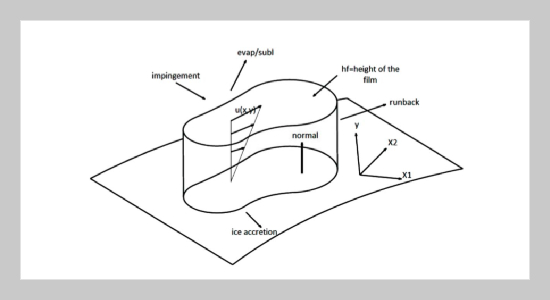REFERENCES
- [1] Messinger, B. L., “Equilibrium Temperature of an Unheated Icing Surface as a Function of Airspeed,” Journal of the Aeronautical Sciences, Vol. 20, No. 1, pp. 29�42 (1953). doi: 10.2514/8.2520
- [2] Bowden, D. T., Gensemer, A. E. and Skeen, C. A., Engineering Summary of Airframe Icing Technical Data, General Dynamics San Diego Ca Convair Div (1963).
- [3] William, O., Shaw, R. and Newton, J., Ice Shapes and the Resulting Drag Increase for a NACA 0012 Airfoil, National Aeronautics and Space Administration (1984). doi: 10.2514/6.1984-109
- [4] Crowe, C., Review-numerical Models for Dilute Gasparticle Flows, J. Fluids Eng.; (United States), Vol. 104 (1982). doi: 10.1115/1.3241835
- [5] Durst, F., Miloievic, D. and Schönung, B., “Eulerian and Lagrangian Predictions of Particulate Two-phase Flows: a Numerical Study,” Applied Mathematical Modelling, Vol. 8, No. 2, pp. 101�115 (1984). doi: 10.1016/0307-904X(84)90062-3
- [6] Scott, J., et al., “Navier-Stokes Solution to the Flowfield Over Ice Accretion Shapes,” Journal of Aircraft, Vol. 25, No. 8, pp. 710�716 (1988). doi: 10.2514/3. 45648
- [7] Hallmann, Mr, Scheurlen, M. and Wittig, S., “Computation of Turbulent Evaporating Sprays: Eulerian Versus Lagrangian Approach,” Journal of Engineering for Gas Turbines and Power, Vol. 117, No. 1, pp. 112�119 (1995). doi: 10.1115/1.2812758
- [8] Ruff Gary, A. and Brian M. Berkowitz, Users Manual for the NASA Lewis Ice Accretion Prediction Code (LEWICE) (1990).
- [9] Shin, J. and Brian, B., “Prediction of Ice Shapes and their Effect on Airfoil Drag,” Journal of Aircraft, Vol. 31, No. 2, pp. 263�270 (1994). doi: 10.2514/3.46483
- [10] Bragg, M. B., “Aircraft Aerodynamic Effects Due to Large Droplet Ice Accretions,” AIAA Paper, pp. 96� 0932 (1996). doi: 10.2514/6.1996-932
- [11] Addy, H. E., Potapczuk, M. G. and Sheldon, D. W., Modern Airfoil Ice Accretions, National Aeronautics and Space Administration (1997). doi: 10.2514/6.1997- 174
- [12] Tsuboi, K. and Kimura, S., “Numerical Simulation of Ice Accretion on a Body with Droplet Flow Model,” AIAA Paper, Vol. 99, p. 3333 (1999). doi: 10.2514/6. 1999-3333
- [13] Morency, F., et al., FENSAP-ICE: a Comprehensive 3D Simulationtool for In-flight Icing, AIAA Paper, Vol. 2566, p. 15 (2001). doi: 10.2514/6.2001-2566
- [14] Baruzzi, G. S., et al., “A Second Order Finite Element Method for the Solution of the Transonic Euler and Navier-Stokes Equations,” International Journal for Numerical Methods in Fluids, Vol. 20, No. 8�9, pp. 671�693 (1995). doi: 10.1002/fld.1650200802
- [15] Shin, J. and Thomas, H. B., Experimental and Computational Ice Shapes and Resulting Drag Increase for a NACA 0012 Airfoil (1992). doi: 10.2514/6.1984-109
- [16] Bourgault, Yves, et al., “A finite Element Method Study of Eulerian Droplets Impingement Models,” International Journal for Numerical Methods in Fluids, Vol. 29, No. 4, pp. 429�449 (1999). doi: 10.1002/(SICI) 1097-0363(19990228)29:43.0. CO;2-F
- [17] Taguchi, G., Introduction to Quality Engineering: Designing Quality into Products and Processes, Tokyo: The Organization (1986). doi: 10.2307/1268824
- [18] Taguchi, G., Tung, L. W. and Clausing, D., System of Experimental Design: Engineering Methods to Optimize Quality and Minimize Costs, Vol. 2 (1987), UNIPUB/ Kraus International Publications.
















